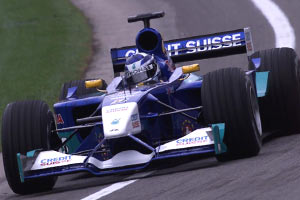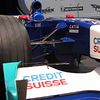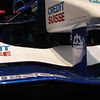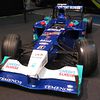Sauber C20 Petronas

Active: 2001
Team: Sauber F1 Team
Team: Peter Sauber (TP), Willy Rampf (TD), Seamus Mullarkey (CA), Osamu Goto (ED), Urs Karatle (CM)
Drivers: Nick Heidfeld (16), Kimi Räikkönen (17)
After several mediocre seasons where Sauber was battling with midfield teams like Arrows, Jordan, Benetton and BAR, Peter Sauber decided it was time for change in an attempt to move up the picking order in Formula One. First of all, both drivers were replaced by a young, nearly rookie duo. Nick Heidfeld came over after a miserable year at Prost Grand Prix, while Kimi Räikkönen only just managed to get a super license because of arguable lack of experience.
In the technical department, former technical director Jost Capito was moved to the engine department and left mid-season. Sergio Rinland, the new chief designer left by the car's launch, while Leo Ress, another former technical director moved to R&D. Behind the restructuring was Willy Rampf who designed the new car having in mind that the team only had the third smallest budget of the field.
The result was a visibly similar car to the Sauber C19, but in reality it wasn't anything like it. Apart from the availability of an excellent Ferrari engine, the team designed a simple but efficient gearbox that made far richer teams jealous. The new car also featured an interesting front suspension set-up, marking the first twin keel front suspension in Formula One. Its design was as simple as possible, with two extensions on each side under the tub to connect the lower wishbones of the front suspension. As a result, the frontal area is cleaned up and allows a much smoother airflow, hence reducing drag.
The car itself was initially designed as light as possible. "We made a very lightweight car," explained Rampf, "and we had to reinforce a lot of components after testing to ensure reliability. Starting with a light car was done on purpose, because then you can reinforce it and make it heavier. It's not possible the other was around".
Even though the team could only afford a single car test team, Rampf eyed car updates at every single race to counteract the drop in performance that the team had experienced in the course of previous seasons.
Apart from performance reasons, the team have no choice but to design a completely new monocoque. Rampf explained: "The new weight-bearing requirement for the rollover hoop structure, and the new side intrusion resistance demands, are very tough and have necessitated a new monocoque chassis. We have also focused on the new aerodynamic rules governing the design and placement of the front and rear wings. Weight reduction is also one of our priorities. It is fair to say that the car is a completely new development."
The C20 was first fired up at Hinwil on 9 January, prior to dispatch to Fiorano, where it ran unbranded ahead of the official launch in Hinwil on 24 January. Heidfeld drove first at Fiorano and completed 64 laps, pronouncing himself very satisfied with his initial experience of the car as he conducted basic systems checks. Raikkonen then acclimatised himself to the C20 for a few additional laps.
It quickly proved to be a successful car for the team as Nick Heidfeld marked a podium in the third race of the season, the Brazilian GP. By the end of the season, there had only been 4 mechanical DNF's and a total of 21 points, enough for 4th place, behind Ferrari, McLaren and Williams.
Specifications
Chassis: Carbon fibre monocoque
Front Suspension: Upper and lower wishbones, inboard springs and dampers (Sachs Race Engineering), actuated by pushrods
Rear Suspension: Upper and lower wishbones, inboard springs and dampers (Sachs Race Engineering), actuated by pushrods
Brakes: Six-piston calipers (Brembo) front and rear; carbon pads and discs (Brembo)
Transmission: Semi-automatic, longitudinally mounted, seven-speed transmission (Sauber), carbon clutch (Sachs Race Engineering)
Chassis Electronics: Magneti Marelli
Tyres: Bridgestone (265/55R13 front, 325/45R13 rear)
Wheels: BBS (12J13 front, 13.7J13 rear)
Weight: 600 kg (including liquids and driver)
Dimensions
Length: 4450 mm
Width: 1800 mm
Height: 950 mm
Front Track: 1470 mm
Rear Track: 1410 mm
Wheel base: 3040 mm
Engine
Designation: Petronas 01A (re-branded 2000 spec. Ferrari)
Type: 3 litre 90° V10, normally aspirated



